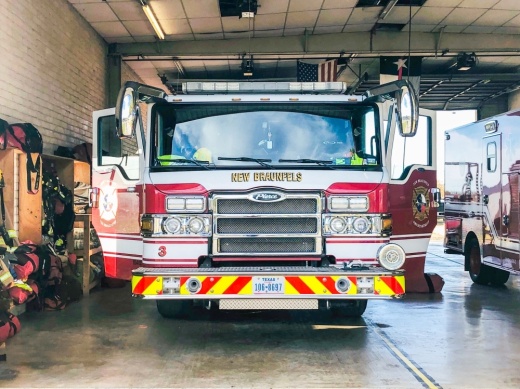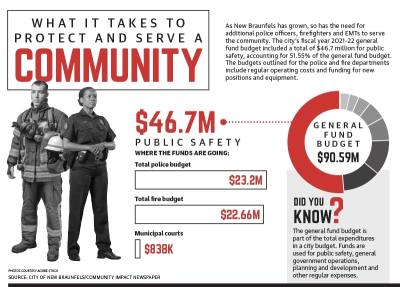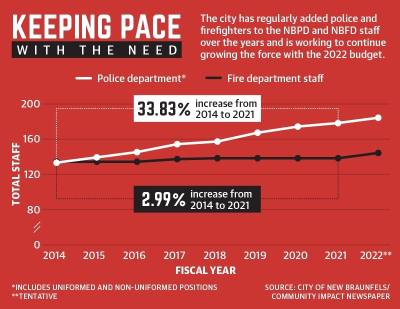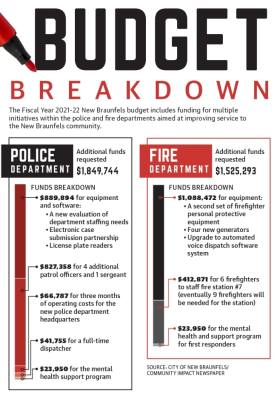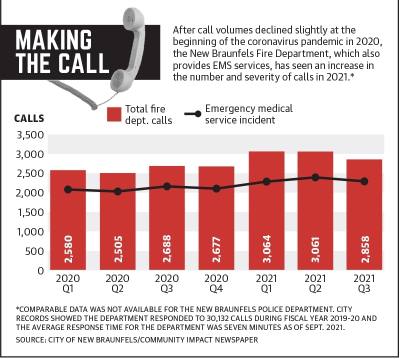“The biggest challenge we face is providing adequate fire and EMS coverage to the exploding population,” said former NBFD Fire Chief Patrick O’Connell ahead of his Sept. 20 retirement after serving the department for 16 years.
As a result, New Braunfels City Council on Sept. 27 unanimously approved its fiscal year 2021-22 budget, which prioritized one-time investments and staffing increases that utilize surplus funding received during the year.
Included in the new budget are funds to add staff to the NBPD and the NBFD as well as one-time investments into technology and equipment requested by the departments.
“We need more police officers; we need more solid waste workers; we need more people in the public works just across the board,” O’Connell said. “We’ve got to make incremental improvements when we can to stretch our tax dollars to the greatest extent possible.”
Funding for six additional firefighters, four police officers, one police sergeant, an internal mental health support program to serve both departments, new equipment and electronic systems are included in the FY 2021-22 budget.
In total $46.7 million, or 51.55%, of general fund expenditures have been allocated to public safety, including $3.38 million in one-time investments.
For O’Connell and NBPD Chief Keith Lane, the investments are just the first step to build more fully staffed teams capable of serving the residents of New Braunfels in a timely and efficient manner.
Though the new positions will not completely meet the needs of both departments, Lane said it is necessary to gradually add positions and equipment as city finances allow.
“Any time that we ask for new positions it’s got to be operationally and fiscally viable,” Lane said.“It has to be strategic, we have to make sure that the city can afford what we’re asking for.”
Investing in public safety
The city’s fiscally conservative FY 2020-21 budget addressed concerns that city revenue would suffer significant drops due to the pandemic’s wide-reaching effects, City manager Robert Camareno said during an Aug. 9 budget meeting.
However, local property and sales tax revenues surpassed projected rates, Camareno said, which allowed departments throughout the city to request funding for one-time and ongoing expenditures.
“Request by request we’re evaluating this opportunity to either address a growing service demand in a department or create the opportunity for the department to be more efficient,” said Jared Werner, chief financial officer for the city.
In the FY 2020-21 general fund budget, the fire department received $25,000 as part of its annual budget for a contract increase with the medical director E-Merge and $16,500 for roof repairs at Fire Station No. 1. The police department was given $11,750 to purchase a utility vehicle.
During the planning process for the FY 2021-22 budget, Werner said the city gave more attention to the needs of the fire department and the police department ahead of the anticipated construction of Fire Station No. 7 and the growing need for patrol officers.
This year, the fire department received approximately $1.53 million in resource requests, including $412,871 to hire six new firefighters and $1.09 million for equipment.
Approximately $1.85 million in resource requests was granted to the police department, which includes $827,358 to hire four officers and one sergeant and $889,894 to purchase equipment and systems.
The NBPD and NBFD will share expenses for the new mental health and support program, with each department receiving $23,950 allocated toward providing mental health care for first responders.
“Public safety makes up the largest portion of the general fund expenditures at $46.7 million,” Camareno said in the Aug. 9 meeting. “For every dollar that we spend on the general fund, 52 cents of that dollar goes to public safety.”
While the percentage of the general fund that is dedicated to public safety has remained relatively comparable year over year—54.6% in FY 2020-21 and 51.55% in FY 2021-22—the city approved more one-time investments through the use of surplus funds to provide long-lasting support for municipal departments, Werner said.
“Funding should make a meaningful impact on improving or maintaining those services that our residents are requiring,” Werner said. “This equipment then reduces those recurring resource demands moving forward and makes us more efficient; that’s the long-term gain.”
Reevaluating police staffing needs
Lane joined the department as interim chief in October 2020 and later became chief in the spring. When he joined the force, he found the department was short 20 patrol officers.
Before Lane joined, some patrol officers had transitioned to newly created specialized officer positions at local schools and municipal facilities, and the department had not fully filled the vacant patrol positions.
Since then, Lane said the department has filled the 20 openings and was approved for four additional officers in June, bringing the staff up to 140 officers.
Lane also inherited an ongoing effort to add more officers to the department following a Center of Public Safety Management study conducted in 2014.
The study indicated that the NBPD was in need of 16 uniformed officers at the time to provide service to the growing population.
The study also included a recommendation to create a “Power Shift” that would be an additional patrol shift to overlap with existing shifts during the busiest times of the day.
Camareno said the department will have added the recommended 16 officers once the four officer and sergeant positions included in the budget have been filled.
Though the addition of the five personnel approved in the new budget will certainly help with staffing concerns, Lane said more officers are needed to adequately serve the community and the department will not add more specialized positions until the patrol shifts are adequately staffed.
“We’re still filling that power shift but the reality of it is those positions are going wherever they’re needed in patrol,” Lane said. “Those positions are all going to go to patrol until we feel like we’re in a position of patrol where we’re fully staffed and ready for the calls.”
To continue growing the police force, Lane said he anticipates the department will request five officers per year over the next few years.
Some residents are concerned that the department has not grown enough to accommodate the increased population.
Michael Morris, a lawyer and resident of New Braunfels, said he believes that not enough resources have been directed to the NBPD to adequately meet the community’s needs.
“Our growth isn’t slowing down,” Morris said. “With the development projects that are coming downtown that are going to involve hundreds of apartments, condos being built, the police department is going to be hard-pressed to keep up with those kinds of demands.”
Between 2014 and 2020, New Braunfels’ population increased from 68,775 to 90,403 residents, according to U.S. Census data. During the same period, the police department grew from 133 staff to 174 staff.
With current staffing levels and a population of more than 90,000 residents, the city has approximately 1.55 full-time law enforcement officers per 1,000 residents.
According to 2019 data from the Federal Bureau of Investigation, 32.1% of cities surveyed with a population of 50,000-99,999 residents had 1.6-2 officers per 1,000 residents, and 31.9% had 1.1-1.5 officers per 1,000 residents. However, there is no nationally accepted standard for the number of officers needed based on population.
Included in the FY 2021-22 budget is $50,000 to contract with the CPSM to reevaluate staffing needs within the police department.
The department has also hosted several testing opportunities for those interested in becoming an officer, Lane said, and more testing will be conducted to find qualified candidates for the available positions.
Prioritizing mental health
As the departments add staff and resources to provide emergency services more efficiently, Lane and O’Connell have also worked to secure funding for a mental health support program for first responders.
The NBPD currently has a unit that works with the Comal County Mental Health Court to serve residents who are dealing with mental health struggles and come into contact with the police, whether through a crime or a referral from the community.
“It’s not just handling them by putting them through the criminal justice system. It is kind of giving them a diversion route,” Lane said. “The court is specific to them and it can help them with their needs, instead of just kind of looking at everybody the same.”
While the department has external programs focused on mental health, O’Connell said the need for internal resources was made more evident during the coronavirus pandemic.
After calls to the fire department declined slightly at the beginning of the pandemic, call volume and severity began to pick back up as lockdown restrictions lifted.
“People continue to defer care either out of fear of going to the hospital or worry about contracting COVID If they were at a hospital or a doctor’s office,” O’Connell said. “We saw an increase in call volume, coupled with an increase in the severity of the types of calls.”
O’Connell said at one point the department was receiving a call regarding a cardiac arrest every day, which took a toll on the resources of the department and staff.
“It psychologically wears on your staff when they have a long string of patients that have poor outcomes,” he said. “All of that is coupled with [the fact that] our folks are human too and they’re dealing with COVID[-19] in the background.”
The rise in emergency calls, challenges with maintaining necessary staffing levels and stress working as a first responder during the pandemic brought to light the need for mental health support for members of both departments.
According to the 2018 Ruderman White Paper on Mental Health and Suicide of First Responders, a research paper, found that first responders are five times more likely to experience depression and Post Traumatic Stress Disorder than other study participants.
However, a 2019 University of Phoenix study showed that 57% of first responders fear negative repercussions for seeking mental health services.
On Sept. 1, Senate Bill 1359 took effect and requires all law enforcement agencies to develop and adopt a policy allowing peace officers access to paid mental health leave.
The Texas Commission on Fire Protection requires all departments to conduct physical fitness assessments to ensure firefighters are healthy, O’Connell said, but he believes mental and psychological fitness should also be evaluated regularly.
“Our culture is one of just being stoic, not asking for help, not showing weakness,” he said. “We realized that we’ve got to make mental health and psychological health a key aspect to the physical assessments that we’re doing.”
Through the new program, first responders will receive trauma resilience training, participate in peer support programs, crisis counseling and an annual resilience assessment, O’Connell said.
The city is currently working to contract with a mental health provider that specializes in treating first responders and military personnel to provide services for the departments.
“I expect that this mental health component will improve resiliency and make it easier for us to accept change,” O’Connell said. “That’s really what is necessary for us to serve New Braunfels moving forward.”




